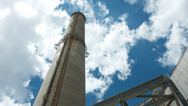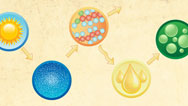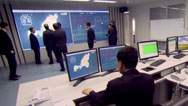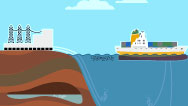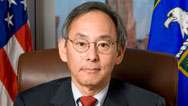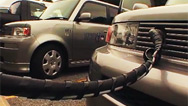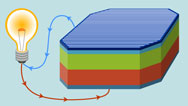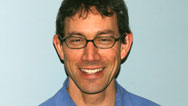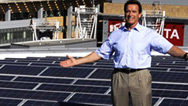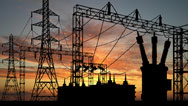
Power Surge
Are we finally on the brink of a clean energy revolution? Airing April 20, 2011 at 9 pm on PBS Aired April 20, 2011 on PBS
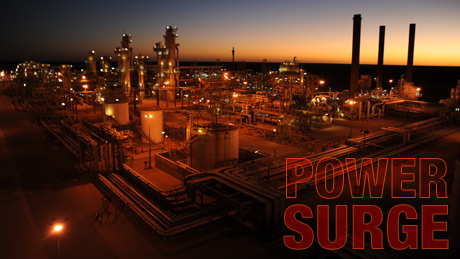
Program Description
Transcript
Power Surge
PBS Airdate: April 20, 2011
NARRATOR: Our modern life is built on energy. We use it to heat, to cool, to light up our cities. It powers our cars and flies our planes. It fills our stores and keeps us switched on and plugged in.
JIM ROGERS (Chief Executive Officer, Duke Energy): In the average home, in 1980, there were three electrical appliances; today there are 25.
NARRATOR: But most of that energy comes from burning coal, oil and gas.
KATE JACKSON (Westinghouse Electric Company): I don't think people consider where their energy comes from.
NARRATOR: Is there a better way?
NATHAN MYHRVOLD (Intellectual Ventures): We need a miracle in energy technology.
NARRATOR: Around the globe there is a race on to find solutions: tapping the of the Sun;...
JAY KEASLING (Joint BioEnergy Institute): This tablespoon of fuel is going to change the world.
NARRATOR: ...cleaning up coal;...
JOHN HOLDREN (Assistant to the President for Science and Technology, Director of the White House Office of Science and Technology Policy and Co-Chair of the President's Council of Advisors on Science and Technology): We need to innovate and we need to innovate faster.
NARRATOR: ...and, in the wake of Japan's tsunami, re-examining nuclear.
STEWART BRAND (Environmentalist and Writer): Nuclear keeps looking pretty good, even with Fukushima in mind.
NARRATOR: Can technology help us fuel our future?
DAN KAMMEN (University of California, Berkeley, Haas School of Business): The carbon problem is actually easily solvable.
NARRATOR: And are we ready for it?
STEPHEN PACALA (Princeton University): Everybody wants it somewhere other than their own backyard. Guess what? If you don't solve the problem, your backyard isn't going to look the same anyway.
NARRATOR: Up now on NOVA, Power Surge.
Most programs about climate change start on a note of doom, with images like this or even this. But this is a program about fixing it, so it starts in a place where it is hard to imagine that there are any problems at all, Sir Richard Branson's private Caribbean island.
SIR RICHARD BRANSON (Virgin Group): When I first saw this island, I'd never seen a more beautiful jewel in my life and completely fell in love with it. The challenge was to make sure you actually enhanced its beauty rather than destroy it.
NARRATOR: Branson, the airline mogul, has even upgraded his little Caribbean jewel with some pretty spectacular flyers.
SIR RICHARD BRANSON: About a hundred years ago, the last flamingo got eaten, so we embarked on a program of reintroducing them to the island.
I think the island is a more perfect island today than it was before we arrived. And I think that's what we've got to try to do with the world.
NARRATOR: But fixing the world isn't easy, even for billionaires. In fact, Branson's love of nature has created a big personal dilemma. He's become super, super rich, while bringing stylish air travel to the masses, and yet, he is also worried about climate change.
Those two passions are like the oil it takes to run his planes and water; they do not mix. Branson's dilemma, while a bit more high-flying than most, is ultimately the same that we all face: how can we get the energy our world needs in a way that won't threaten it?
SIR RICHARD BRANSON: Climate change is one of the greatest threats.
NARRATOR: Branson's solution is to use his entrepreneurial muscle and profits to attack climate change, an idea inspired by another famous Brit, Winston Churchill.
SIR RICHARD BRANSON: The threat of carbon could be worse than World War I, World War II put together. If that was the case, Churchill would get a war room set up, and he would rally industry, he'd rally the troops and try to beat carbon, the enemy. And so, we set up the Carbon War Room.
NARRATOR: Branson is not alone. Right now, in laboratories around the globe, there is a race on to find solutions. And the outcome is uncertain, but ultimately, the question is: can technology save us from climate change?
Power Surge investigates those solutions.
There is no better place to start than deep in this West Virginia coal mine. Coal, which generates half of all U.S. electricity, tells a story millions of years old.
Thirty-five million years ago Earth's atmosphere was awash in carbon dioxide. But this is what Earth looked like: alligators in South Dakota, palm trees in the Rocky Mountains, and instead of being covered by ice, there were forests in Antarctica. Over millions of years, those trees pulled the carbon out of the air to grow. And when they died, much of that carbon got buried underground. The same process created the coal we see here, in West Virginia.
Coal is up to 86 percent carbon. A gallon of gasoline, another fossil fuel, represents a hundred tons of ancient plants. That's why gas, coal and oil are called fossil fuels. With the advent of the industrial age, that carbon-rich coal and oil was dug up and burned as fuel.
Burning anything releases carbon, but carbon-dense coal and oil release a lot. That carbon, long buried, combines with oxygen in the Earth's atmosphere and acts like a blanket, trapping heat. This NASA map shows global temperatures rising over the last century.
No one is sure precisely how much the temperature will rise or how quickly, but the atmospheric carbon predicted for the end of this century is approaching the level from 35 million years ago, when those alligators swam in South Dakota.
The task ahead is to cut carbon emissions. And that is exactly what Stephen Pacala has figured out how to do. Pacala is an environmental biologist at Princeton University and a serious woodworker. He has used both skills to demonstrate how we can solve our carbon problem. He calls it the "wedge theory."
STEPHEN PACALA: It is easy to say, "Oh, the energy problem is so big that we can't possibly build enough wind turbines to solve it, we can't possibly do enough conservation to solve it." So you break the problem into pieces and say, "What are the technological options across the board that we have to throw at it?"
NARRATOR: Pacala says the problem can be easily visualized.
STEPHEN PACALA: This is the amount of emissions that humanity puts out annually—its carbon emissions, its greenhouse gas emissions—and this is time. And what happened...for the first 10,000 years, since the end of the last Ice Age, people emitted almost nothing, just a little bit, associated with farming. But then the industrial revolution happened, and emissions started to increase, because of the burning of coal and then oil and then natural gas, and have increased and increased and increased. And they are still increasing, today. Instead of allowing them to climb, we've got to freeze them. So this triangle, here, is the size of the problem. It's the gap between what we were going to do and what we must do.
NARRATOR: Pacala says this triangle represents the challenge: it is the carbon emissions that we must somehow keep out of the atmosphere.
To help make this easier to understand and more fun, Pacala decided to turn it into a game, literally.
STEPHEN PACALA: One Christmas, I was at home, and my kids were fighting inside about something, and I decided to go outside and build something.
NARRATOR: He used his woodworking skills to build the Wedges Game.
Here's how it works: he turned the area that is the problem into a triangle. This represents the total amount of carbon dioxide we must avoid putting into the atmosphere in the next 50 years. The ideal target is controversial, but Pacala calculated it was seven billion tons, per year. He divided that up into one-billion-ton sections. Next he made wood wedges that represent technologies that could fill in that triangle.
STEPHEN PACALA: We said, "Is there any technology that is big enough to do a seventh of the problem?" And the answer was, lo and behold, there were 15 already in the marketplace at an industrial scale. These are not pie-in-the-sky things, these are things that you can go and visit on a field trip.
NARRATOR: Most of the 15 wedges can be grouped into four simple categories. This green wedge represents the easiest and cheapest: efficiency, like increasing the fuel mileage of all cars from 30 to 60 miles per gallon. This yellow wedge represents tripling the number of nuclear power plants over 50 years. This blue wedge represents cleaning coal plants by burying their carbon emissions. And this red wedge represents the Sun, harnessing its power with solar panels or wind turbines.
STEPHEN PACALA: This has two different wedges of nuclear.
NARRATOR: Pacala and his Princeton colleague Robert Socolow did the complicated analysis behind this simple game to prove that it could be done. The way you play the game is to fill the triangle with seven of the 15 available technological wedges and create your own solution to the climate crisis. Some people might use more solar energy, others more efficiency savings.
STEPHEN PACALA: I'm going to nominate a wedge of efficiency.
ROBERT SOCOLOW (Princeton University): Yeah, I think in efficiency, one wedge is modest, so we can put in two more of these nice green efficiency wedges.
NARRATOR: The point is that there are many possible solutions. It all depends on our choices.
Drawing the blueprint for a solution to this problem is deeply challenging. To help, NOVA has assembled a panel of experts, leaders from business, academia and government, who are all trying to find solutions.
STEPHEN CHU (United States Secretary of Energy): Can technology save us? Yes, it can, it should, and it must. That's the thing: it must save us.
PAUL ALIVISATOS (Director, Lawrence Berkeley National Laboratory): Can technology save us from climate change? Absolutely. I'm very convinced that it can. And, in fact, beyond that, what I would say is that it's an incredible opportunity for us to create all kinds of new things.
JIM ROGERS: I know we can do things that we can't dream of today. We can't envision what it will look like 100 years from now.
DAN KAMMEN: The carbon problem is actually easily solvable. What's hard is that we need to make a lot of change in a hurry. We, more or less, have the coming four decades to recreate a green version of the industrial revolution that's taken us 150 years.
STEPHEN PACALA: There are people right now who go to work every day and they can say to themselves, "You know, if I get lucky today, I will, arguably, save the world and become not just the richest person in it, but the richest person ever!"
SIR RICHARD BRANSON (File Footage): Climate change will create more wealth than any other sector over the next decade.
NARRATOR: Richard Branson knows the power of profits to spark innovation, so he has started a $25 million contest for the best idea to reduce carbon levels.
AL GORE (Former Vice President of the United States/Judge, Earth Challenge): Is there some way that some of that extra CO2 might be scavenged efficiently out of the atmosphere?
NARRATOR: One of the people working to do that, and hoping that Branson might make his Christmas come a bit early, is Klaus Lackner, a physicist at Columbia University. Lackner's idea is brilliantly simple: why not develop technologies that work just like trees, removing the carbon pollution that our cars and Branson's planes make?
KLAUS LACKNER (Columbia University): Everyone knows it can be done: every submarine has to pull that CO2 out of the air people breathe inside.
NARRATOR: Carbon capture is not a new idea. The Navy has relied on it for decades. Deep underwater, submariners exhale carbon dioxide with every breath. In such a small, enclosed space, that CO2 builds up and becomes toxic. In every submarine, the CO2 must be removed from the air for the sailors to survive.
That's done with some pretty basic chemistry, using a machine called a scrubber. The carbon in a carbon dioxide molecule has a slight positive charge. If the chemical filter inside the scrubber has a special negative charge, the carbon dioxide will be drawn to it like a magnet.
In his lab, Lackner found a resin-based material that acts just like the submarine scrubber, attracting carbon dioxide to stick to it. The next challenge was how to capture carbon naturally in the breeze, without using energy. Lackner experimented with various shapes, from rigid flat panels to material draped like a flag. He discovered that cutting the material into very thin strips and putting them along a wire would be most effective. The result: a manmade carbon collector, highly engineered at one of America's top universities, that looks, in the end, like a branch of a Christmas tree.
KLAUS LACKNER: These two branches look very much alike because they, functionally, try to do, more or less, the same thing. But these materials are about 1,000 times better at collecting CO2 from the air than a natural tree is.
NARRATOR: Lackner's vision is that one day there would be a fleet of carbon-eating vehicles, each about the size of an 18-wheeler, sucking up the unwanted carbon from Richard Branson's planes or those New York City cabs.
Our modern world has an insatiable appetite for energy. It is tied to economic growth and prosperity. Currently, fossil fuels feed 85 percent of that demand.
KLAUS LACKNER: It's very difficult to solve the climate change problem without having some component where fossil fuels are still used, and we are taking the CO2 and capturing it and storing it safely and permanently.
JIM ROGERS: Coal is really critical, not just because 50 percent of electricity comes from coal in the U.S., but 80 percent of electricity in China comes from coal.
NARRATOR: Jim Rogers, the C.E.O. of one of America's largest electric utilities, says figuring out how to clean up coal must be part of the solution.
JIM ROGERS: The issue becomes, "Can we clean it up?" That is the technology challenge that we have, because you just can't wake up tomorrow morning and say, "No more coal,"...not going to happen.
NARRATOR: Rogers says we need to be finding ways to capture and store carbon, like Lackner is doing in his lab, but on a very large scale.
JIM ROGERS: We need to do it with a sense of urgency. We are not moving fast enough.
NARRATOR: The process of capturing carbon and burying it is happening on a massive scale, in a place where people don't take taxis, they take camels: the Sahara Desert, Algeria, a location so remote and difficult to get to, we had to fly there on British Petroleum's chartered flight from London.
In Salah was once an important trade link in the middle of the Sahara desert. Today, it may be an important link to our energy future. North Africa is rich in natural gas. At In Salah, that gas, which might heat your home and fuel your stove, comes out of the ground with up to 10 percent carbon dioxide mixed in, an impurity that would make your stove burn less efficiently. So the carbon dioxide is scrubbed out, like in a submarine. Usually, that carbon dioxide is just released into the atmosphere, but here at In Salah, it is pressurized and pumped through huge pipes that stretch across the desert.
Five miles away, the gas makes an unexpected turn. Here, at the KB-502 site, the Algerian national gas company and B.P. are putting the carbon dioxide right back where they found it: underground. Geologist John Midgley is checking up on the gas pressure.
JOHN MIDGLEY (BP Alternative Energy): This is the injector wellhead for KB-502. In this pipe is the carbon dioxide that's being compressed at the production facility. The noise you hear is the flow of gas.
NARRATOR: The pressurized carbon dioxide is then forced more than a mile below the surface, where it is pushed into a porous rock formation and effectively trapped back underground.
STEPHEN PACALA: That facility takes a power-plant's worth of CO2 and injects it deep under the Earth.
NARRATOR: In the Wedges Game, capturing the CO2 like this, from 1,600 natural gas plants, would provide one wedge or one-seventh of the needed solution. But doing this is expensive and would increase the price, so, at present, In Salah is one of only four such facilities in the world, operating at a large scale.
STEPHEN PACALA: There aren't more of these right now, because there is no commercial reason to do them. If the price of fossil fuel reflected the damage that was caused by the greenhouse gases, then, all of a sudden, there would be an economic reason to store the carbon dioxide below ground.
NARRATOR: Given that the gas is invisible, how do they know it is actually staying underground? Satellite measurements reveal the surface of the Earth at the site actually moving.
JOHN MIDGLEY: We can calculate how much movement there is in the Earth's surface after we've backed out calculations for Earth tides, planetary motions.
NARRATOR: The sands of the Sahara are stretched up to 12 millimeters to make room for the carbon dioxide injected inside. So, if carbon dioxide from a single natural gas plant can literally move the surface of the Earth, what is the impact of all of the carbon our modern life creates?
We produce nine billion tons of carbon a year, a number so hard to fathom that we decided to break it down into something more manageable and personal.
DAN KAMMEN: When you look around your home, there are some obvious places where we use a lot of energy, and for most people, we generate a lot of carbon.
NARRATOR: Dan Kammen of the University of California at Berkeley has tried to figure out the carbon footprint of the average American: heating our homes, driving our cars, growing and shipping our food.
DAN KAMMEN: We know how much carbon is associated with each unit of energy we use in our house. Adding those things up is basic accounting.
NARRATOR: Kammen developed a Web site where you can calculate your carbon footprint, but we wanted to make it a bit more graphic. So we asked him to imagine it as a solid, like garden compost, which is mostly carbon anyway. One pound of carbon, emitted as an invisible gas, can be represented as a pound of this rich black dirt.
DAN KAMMEN: A 20-mile trip to the store and back, that is about six pounds of carbon.
NARRATOR: One short trip: six pounds. But in one year, the average American drives about 10,000 miles.
DAN KAMMEN: This is the average American's driving for the year: two tons of carbon.
NARRATOR: All those car trips: two tons.
And all the driving, flying, buying, and heating we do in a year?
DAN KAMMEN: Six tons.
And to show you your average family's carbon footprint, I've invited my kids to join me. And this is the average American's carbon footprint for just one year.
TEXT ON SCREEN: One Family. One year. 14 tons.
NARRATOR: Your average family's 14 tons of carbon waste combines, in the atmosphere, with oxygen, to create 50 tons of carbon dioxide gas. That gas, floating in the atmosphere, lets sunlight enter to warm Earth, but it blocks much of the heat from escaping. It is like an invisible GORE-TEX® blanket warming our Earth.
So how can we get energy with the least amount of carbon emissions?
First up on everyone's green energy list: the Sun. Solar power is the poster child for transforming our energy system.
JOHN HOLDREN: There's huge potential. If you look at the numbers, the amount of solar energy reaching the surface of the Earth is 100,000 terawatts. And the amount of energy that civilization is using for all of its purposes today is 17 or 18 terawatts. This makes solar energy enormously attractive.
STEPHEN PACALA: You know, you only need a few square meters of solar panels for every person in the world to actually generate all the energy in the world. The reason we don't do that is it's still too expensive. Solar panels cost a lot of money. The question is, can we make photovoltaics cheap?
NARRATOR: Making solar power cheaply is now the goal. And with billions at stake, there is a race on to do it.
There is no better place to see the intensity of that race than here in China. China leads the world in the manufacture of solar panels, and it's not just because of cheap labor.
A big part of it's down to this man: Zhengrong Shi, the C.E.O. of Suntech, and a remarkable rags-to-riches story.
ZHENGRONG SHI (Suntech Power Holdings Co. Ltd.): People think you get your fortune overnight, but I never believed that. It is not true for anybody. It's not true, unless you have a rich father; that's different.
NARRATOR: Shi's family was far from rich. In fact, his father was so poor that Shi was put up for adoption. Now he is known as the "Sun King," and is ranked among the richest men in the world.
ZHENGRONG SHI: I'm a very aggressive personality, so when I saw an opportunity in solar, I just moved very quickly.
NARRATOR: Before hitting the jackpot, Shi was a solar scientist in Australia, but felt the best way to get solar out to the world was not through publishing papers, but through combining science with business.
The initial reaction from his university colleague and teacher Stuart Wenham was not encouraging.
STUART WENHAM (University of New South Wales) Well, to be honest, when he first mentioned to me his idea, I didn't think it was a good idea, and I told him so.
NARRATOR: Today, Shi's former teacher is his chief technology officer. Instead of perfecting technology in the lab, they are using their science to cut the cost of solar.
The basic science of photovoltaic technology is pretty straightforward and has been around since the 1950s. "Photo" means light, and so, when a photon of light hits a silicon atom, its energy knocks an electron loose, which is then directed through the silicon to the thin wires on the cell. That stream of electrons is electricity that can power anything from your toaster to your TV.
During the manufacturing process, metal lines that work as wires are put on the surface of the silicon.
STUART WENHAM: The problem is these metal lines cannot be made very narrow. That shades quite a bit of the solar cell surface.
NARRATOR: One way Wenham and Shi are working to improve their cells is by making the wires thinner and closer together, so the electrons don't have to travel so far.
STUART WENHAM: If you look at the solar cell here on my left, the metal lines are a lot closer.
NARRATOR: The new design increases efficiency, which drives down the costs.
It's innovations like these that have led Shi to dominate world production. In 2001, it would take Suntech a whole year to produce what now rolls out of the factory in two days. That kind of growth can be seen across China, where they are adding the equivalent of a city the size of Chicago, every three months.
Nowhere is the enthusiasm for solar power more celebrated than in Dezhou, three hours south of Beijing. At night, the city is alight with neon that is powered by batteries, charged in the day by an enormous array of solar panels.
The man behind this showcase city is Huang Ming, another of China's solar millionaires.
HUANG MING (Himin Solar Energy Group): Solar Valley is my dream of a new kind of landscape or lifestyle.
NARRATOR: Now, Huang Ming wants to spread his wealth and passion for solar around.
ORVILLE SCHELL (Asia Society): Huang Ming has been possessed by this vision to design a community, which, in his case, I think, is 88 percent solar-reliant.
NARRATOR: Orville Schell, the China scholar, has been to Dezhou. While it may be flashy, he says, it's emblematic of China's growing prosperity.
ORVILLE SCHELL: In China today, you see the most amazing things springing up. In some sense, they're very impressive, involving a lot of very innovative technology. And then there are these weird other aspects of them. But there is this extraordinary dynamic energy that sort of bursting forth.
NARRATOR: And it's not just China, the energy problem is seen as an opportunity all over the world.
STEPHEN CHU: China is moving very aggressively, India is beginning to move, Western Europe is beginning to move on this. Even some oil-exporting counties, OPEC countries, are beginning to realize that you need to develop cleaner energy sources.
NARRATOR: Since coming to the Department of Energy, Secretary Steven Chu has increased spending on developing clean energy by $40 billion.
STEPHEN CHU: You need technologies: solar power, wind power, carbon capture. Who is going to supply the world with those technologies? I would hope it is the United States.
NARRATOR: The U.S., once, was enthusiastic about solar: at the height of the oil crisis in the 1970s.
JAMES EARL (JIMMY) CARTER, JR. (President of the United States, 1977-1981/File Footage): By the end of this century, I want our nation to derive 20 percent of all the energy we use from the Sun.
NARRATOR: To great fanfare, President Jimmy Carter even installed solar heaters on the roof of the White House. But a few years later, after oil prices dropped, Ronald Reagan took the panels down.
Today, America is trying to get back into the solar game.
STEPHEN CHU: The bottom line is we roughly want to double the amount of clean energy.
NARRATOR: The goal for Secretary Chu is to double the amount of non-carbon emitting energy in the U.S. by 2035, and a large chunk of that is solar.
STEPHEN CHU: Along comes a need: we need clean energy; this is a problem that science can solve. That opportunity is huge.
NARRATOR: The idea is to invest in science that will pay off in practical solutions.
One of the major challenges we face is transportation, which accounts for about a third of total energy use. There are several different approaches, including electric cars, hydrogen fuel cells and biofuels.
STEPHEN PACALA: Transport fuels represent a special problem. The most likely avenue they're currently...that people are pursuing is biofuels.
NARRATOR: Biofuels are a form of solar, because they come from plants, which capture the Sun's energy to grow.
One promising approach is being developed at the Joint BioEnergy Institute, in Emeryville, California, where Jay Keasling is using plant biology to come up with the fuel of the future that will work with our current system.
JAY KEASLING: We've got about three trillion dollars' worth of transportation infrastructure in this country, with the gas stations, the pipelines, the refineries, all of that; automobiles, trains, planes. We don't have the money to remake all of that.
NARRATOR: Keasling's idea is to exploit the way plants make food. Plants absorb carbon dioxide from the air and use that carbon, and oxygen and hydrogen from water, plus the Sun's energy to make nutrients in the form of a simple sugar.
Keasling is working to put that sugar to use for our benefit. One way to think about how he is doing that is he is super-charging an age-old process: brewing beer. The basic recipe of beer is to take barley, a plant that is rich in those stored sugars...
JAY KEASLING: Tastes pretty good.
NARRATOR: ...and mix it with yeast. Yeast is a microbe that feeds on those plant sugars and turns them into alcohol. That process is called fermentation. Lars Larson, the brewmaster, explains.
LARS LARSON (Trumer Brauerei): Yeast is instrumental to the brewing process. It is the yeast that turns the sugar into alcohol and creates beer. Let's put it this way, in every animal's lifecycle, something goes in the front and come comes out the back. Alcohol and CO2 come out the backside of yeast.
NARRATOR: But instead of alcohol that you drink, Keasling wants to make diesel fuel by genetically altering the yeast.
JAY KEASLING: We have an enormous power to change biology and manipulate biology.
NARRATOR: Instead of barley, the plant he uses is switchgrass. It's an agricultural waste material, but its sugars aren't easy to access.
JAY KEASLING: We have to go to great lengths to extract the sugars and turn them into this.
NARRATOR: Then he feeds the sugar to genetically altered yeast, like at the brewery, but what comes out of the backside of this yeast, you can put directly into your car or your plane.
JAY KEASLING: This is not your grandmother's yeast. This yeast has been souped up to produce an advanced biofuel, a fuel that is nearly identical to what we have today.
NARRATOR: There is just one catch: the cost.
JAY KEASLING: If Richard Branson came here today, I could give him a tablespoon of jet fuel that we made here in the laboratory. That tablespoon would cost about $100,000.
SIR RICHARD BRANSON: Well, I would absolutely love to meet up with him. It's just fantastic to have all these people trying to come up with the big breakthroughs. I think the breakthroughs will happen. It needs money, resources, time, energy, great, great people to put their minds to it.
STEPHEN PACALA: I firmly believe that technology can save us from climate change, but the changes that we're talking about are heroic in scale. They are not without precedent, but they are still heroic in scale.
NARRATOR: One challenge is to figure out which advances in the laboratory can be increased to an industrial scale; not all promising science is practical.
But in the Wedges Game, there is an immediate way to reduce the size of the problem. The potential is huge, and it's called efficiency.
STEPHEN PACALA: The very word "efficiency" says you get the same bang for less buck. Efficiency is a car that gets better M.P.G. It's a house that doesn't leak heat, so you have the same amount of warmth inside the house, with less natural gas burned.
NARRATOR: Not using energy in the first place is the easiest way to earn a wedge. It's like the old Benjamin Franklin quote, "A penny saved is a penny earned."
Ben Franklin, himself, would be proud of what is going on here at the National Archives, in Washington, D.C.
The Archives is all about saving America's most important documents—like the U.S. Constitution, which Franklin signed—but it paid very little attention to saving energy.
Today, that's all changed. James Garvin was once just the building's engineer, but now he's also become a detective. Using a thermal imaging camera, Garvin is tracking down energy leaks.
JAMES GARVIN (National Archives): We're looking for leaks, to see areas where we're losing a lot of energy.
NARRATOR: Red means hot, which is wasted energy. Obviously, the problems start right at the front door.
JAMES GARVIN: We don't need a special camera to see the problem here. You can feel the heat through the three-quarter-inch gap.
NARRATOR: That escaping heat may help this guy outside stay warm, but the point is to keep all the heat inside the building. So, the Archives has pulled in efficiency experts to reduce its carbon footprint.
They installed new efficient radiators and lights that are 20 percent brighter, yet use a third less energy, and motion sensors that shut them off when employees don't. But the biggest ticket items were installing efficient boilers and plugging those leaky gaps.
The Archives is on track to reduce its emissions by more than 1,000 tons of carbon a year. That reduction doesn't just show up in Garvin's camera as good news blue, it is also saving the Archives a lot of green. Its energy bill will be reduced by $1.2 million every year, which will pay for the upgrade in only five years.
STEPHEN PACALA: Everybody loves efficiency. Efficiency saves you money, it doesn't cost you money.
NARRATOR: Efficiency savings aren't just limited to grand old government buildings. About a quarter of the energy an average American uses is at home. Increasing home efficiency can save a third on your energy bill. And we know our cars can go farther on a gallon of gas.
STEPHEN PACALA: If you took all the cars that are going to exist in the world 50 years from now, and made them have 60 miles per gallon instead of 30 miles per gallon, that creates a wedge. It averts one billion metric tons of carbon atoms that would have been emitted to the atmosphere, while still providing us with the travel we want.
NARRATOR: That one change is the equivalent of replacing 800 coal plants, and that's just the beginning of what efficiency improvements can do.
In the 1970s, energy efficiency got a lot of attention, but for many it was symbolic of a counter-culture lifestyle and making uncomfortable sacrifices. But as Stewart Brand, a leader of the environmental movement back then, points out, efficiency changes in California have kept energy use the same, while still allowing the economy to double.
Brand became famous for writing The Whole Earth Catalog, a resource guide for a sustainable lifestyle. Today, he says it's important to develop a whole new catalogue of tools to fight climate change: from harnessing wave energy, to offshore winds, to using Earth's geothermal heat.
STEWART BRAND: It is encouraging for people to hear that we're not betting everything on one particular thing. Is...somehow wind is going to save us or somehow nuclear is going to save us? It is such a full-spectrum problem, it's going to take a full-spectrum set of solutions.
NARRATOR: Brand has surprised many by his willingness to consider this full spectrum. In the 1970s, he fought nuclear energy. Today, he has done an about-face.
STEWART BRAND: The shift was starting to really take climate change seriously enough to challenge my own assumptions that I knew enough about nuclear.
NARRATOR: But the tsunami in Fukushima, Japan has revived old fears about nuclear energy. When the tsunami struck, this 1970s-style reactor was flooded, and its diesel generators didn't work, causing the cooling system to fail. That led to releases of radiation.
Does this disaster change Brand's mind?
STEWART BRAND: Has Fukushima changed my support of nuclear? No. I think the question we are asking now is comparing risk of nuclear to the risks of climate change? When you do that risk analysis, nuclear keeps looking pretty good, even with Fukushima in mind.
NARRATOR: According to the Wedges Game, replacing 800 coal plants with nuclear power would solve one wedge of the needed carbon solution. But can nuclear be made safer?
Nuclear power plants require massive cooling systems to keep the reactor core safe. In the old style plants, like those in Japan, that was done with a vast array of pipes, valves and backup pumps. It was the failure of these backup systems that led to the nuclear crisis.
The latest designs for reactors, like this Westinghouse AP1000, are much simpler. An example is the large tank of cooling water that sits right on top, so that gravity will do the work in the event of emergency. This tank has a three-day supply of cooling water and requires no electricity.
This next generation of nuclear plant is already in production, but to see it, we have to go back to China, because no nuclear plant has been built in the U.S. since the 1970s.
Kate Jackson, Chief Technology Officer for Westinghouse, says one key benefit of the AP1000 is that it is bringing standardized designs to nuclear.
KATE JACKSON: Standardization is an old concept, it's just never been applied to the nuclear industry before.
NARRATOR: The old nuclear plants were custom-built, with more moving parts to go wrong. Now, each plant is built in standardized modules like a giant LEGO® set.
KATE JACKSON: So the doors are attached, the valves are in, the piping is installed, it's been pressure tested. It's ready to go.
NARRATOR: There are a total of 350 modules for each power station. They're packed up, loaded up and trucked to the site, like here in Sanmen, four hours outside of Shanghai, where Kate Jackson has come to see the progress.
KATE JACKSON: It's wonderful, because you get to see these building blocks being moved and put into place.
NARRATOR: Piece by piece, the nuclear power station takes shape.
Stepping inside, Jackson finds the reactor core. This is where the nuclear reaction will generate the heat that drives the electrical generator—enough power for more than a million homes. The plant at Sanmen should come online in nearly half the usual time, only four years.
Over the next 30 years, China plans to build 400 nuclear reactors.
Designs like the AP1000 could address some of the safety concerns that Japan's crisis exposed, but there are still many old-style plants in operation, 23 in the U.S. alone.
And all nuclear plants suffer from the long-standing problem of how to dispose of their nuclear waste. Nathan Myhrvold thinks these problems can be overcome.
NATHAN MYHRVOLD: Nuclear is one of the carbon-free emission technologies that absolutely works at scale, today.
NARRATOR: In Seattle, Myhrvold, former Chief Technology officer of Microsoft, is teaming up with his old friend Bill Gates, to work on designing a future generation of nuclear technology called TerraPower.
NATHAN MYHRVOLD: We need a miracle in energy technology. Saying we need a miracle sounds extreme, but, in fact, miracles-on-demand are what the entire technology industry about.
NARRATOR: The miracles Myhrvold predicts are new designs that would more safely and efficiently use spent nuclear fuel, which is creating the waste problem today. He looks to technology not just to provide energy for us, but to satisfy the aspirations for growth in the rest of the world.
NATHAN MYHRVOLD: I think the energy task for the 21st century is how can we get every citizen on Earth the kind of energy usage you find in the developed world? It is a question of fairness and equity. Some people say we, in the United States, we ought to use a lot less, and perhaps we ought to. I don't know a way to force us to use less. And then they say the Chinese ought to not to use as much as we use now, but they are headed there, and I don't know how you stop them.
NARRATOR: The demand for energy indeed appears unstoppable. In fact, energy demand is predicted to triple, by the end of the century, which means there is probably a need for all the solutions science can come up with.
JOHN HOLDREN: People always are looking for the technological magic bullet, the one thing that, if we just get it right, it will save us. There probably is no silver bullet. There may be a silver shotgun, in the sense of a wide variety of advance, which together will solve a large part of this problem.
STEPHEN PACALA: One big nuclear power plant is the same as 3,000 big wind turbines, and it's the same as about 50 square miles of P.V. solar panels. The question is, "Which do you want?" And the answer is everybody wants it somewhere other than their own backyard. Well guess what? If you don't solve the problem, your backyard isn't going to look the same anyway.
NARRATOR: And the energy problem is a moving target. Every day as demand grows, and carbon accumulates in the atmosphere, the problem increases.
STEPHEN PACALA: This is a problem in which procrastination carries really serious penalties.
NARRATOR: America has been down the path of procrastination before, perhaps one of the most poignant places to see the results of that is back in China, at a town pulled out of poverty by solar manufacturing. At the Dezhou Solar Museum there is a popular display: one of the solar panels that Jimmy Carter installed on the White House, back in 1979.
JIMMY CARTER (File Footage): This solar heater can either be a curiosity, a museum piece, an example of a road not taken, or it can be just a small part of one of the greatest and most exciting adventures ever undertaken by the American people: harnessing the power from the Sun.
NARRATOR: Thirty years later, the need to venture into new forms of energy is even greater. The challenge is huge; the potential consequences of inaction are bigger.
STEPHEN CHU: If necessity is the mother of all invention, we got the biggest necessity, and it has to be the mother of many inventions.
Broadcast Credits
Power Surge
- Produced by
- Doug Hamilton
- Co-Produced by
- Alexis Bloom
- Written by
- Doug Hamilton
- Edited by
- Rob Tinworth
- Associate Producer
- Jessica Harrop
- Camera
- Brad Dillon
Rob Tinworth
Dan Krauss
Erich Roland
Richard Ranken
Greg Andracke
Howard Shack
Jon Else
Rich White
Doug Hamilton - Sound Recordists
- Lee Keen Foong
Doug Dunderdale
Len Schmitz
Kuz Randhawa
Everett Wong
Elijah Lawson
Rick Albright
Paul Rusnak - Narrated by
- Ted Marcoux
- Assistant Camera
- Rylan Morris
- Music
- Tay Chee Wei
- Music Mix
- Lee Wei
- Animation Design
- Mitch Butler Explain-O-Graphics, LLC
- Additional Animation
- Pixeldust Studios, LLC
- Additional Editing
- Jessica Harrop
Naftali Beane Rutter - Colorist
- Michael H. Amundson
- Audio Mix
- Greg McCleary
- Research
- Sharon Kay
- Production Assistants
- Fu Qing
Clare Major - Archival Material
- ABCNEWS VideoSource
AP Archive
Archive Films/Getty Images
Bloomberg/Getty Images
BP Alternative Energy
CA Energy Commission
Consol Energy Inc.
Corbis
Discovery Access
Image Bank Film: Signature/Getty Images
iStock Footage/Getty Images
Jeff Grewe
Jerry Mason/Photo Researchers, Inc.
Jimmy Carter Library
NASA
Streamline Films, Inc.
Suntech Power
WireImage Video/Getty Images - Special Thanks
- Ali Alaoui, Algerian Embassy Washington DC
American Soil & Stone Products Inc.
Dr. Heidi Cullen, Climate Central
Jason Felts, Virgin Produced
Marian Koshland Science Museum
National Archives - NOVA Series Graphics
- yU + co.
- NOVA Theme Music
- Walter Werzowa
John Luker
Musikvergnuegen, Inc. - Additional NOVA Theme Music
- Ray Loring
Rob Morsberger - Closed Captioning
- The Caption Center
- Publicity
- Eileen Campion
Victoria Louie
Karen Laverty - Marketing
- Steve Sears
- Researcher
- Kate Becker
- NOVA Administrator
- Kristen Sommerhalter
- Production Coordinator
- Linda Callahan
- Paralegal
- Sarah Erlandson
- Talent Relations
- Scott Kardel, Esq.
Janice Flood - Legal Counsel
- Susan Rosen
- Associate Producer Post Production
- Patrick Carey
- Post Production Supervisor
- Regina O'Toole
- Post Production Editor
- Rebecca Nieto
- Post Production Manager
- Nathan Gunner
- Compliance Manager
- Linzy Emery
- Development Producers
- Pamela Rosenstein
David Condon - Supervising Producer
- Stephen Sweigart
- Business and Production Manager
- Jonathan Loewald
- Senior Producer and Project Director, Margret & Hans Rey / Curious George Producer
- Lisa Mirowitz
- Coordinating Producer
- Laurie Cahalane
- Senior Science Editor
- Evan Hadingham
- Senior Series Producer
- Melanie Wallace
- Executive Producer
- Howard Swartz
- Managing Director
- Alan Ritsko
- Senior Executive Producer
- Paula S. Apsell
A NOVA Production by Hamilton Land & Cattle, Inc. for WGBH-Boston
© 2011 WGBH Educational Foundation
All rights reserved
Image
- (power plant, Algeria)
- © WGBH Educational Foundation
Participants
- Sir Richard Branson
- Virgin Group
- Steven Chu
- U.S. Secretary of Energy www.osti.gov/accomplishments/chu.html
- Al Gore
- Judge, Earth Challenge
- John Holdren
- White House Office of Sci & Tech Policy
- Daniel Kammen
- University of California, Berkeley
- Jay Keasling
- Joint BioEnergy Institute
- Klaus Lackner
- Columbia University
- John Midgley
- BP Alternative Energy
- Huang Ming
- Himin Solar Energy Group
- Stephen Pacala
- Princeton University
- Jim Rogers
- Duke Energy
- Orville Schell
- Asia Society
- Zhengrong Shi
- Suntech Power
- Stuart Wenham
- U. of New South Wales
Preview
Full Program | 53:07
Full program available for streaming through
Watch Online
Full program available
Soon

